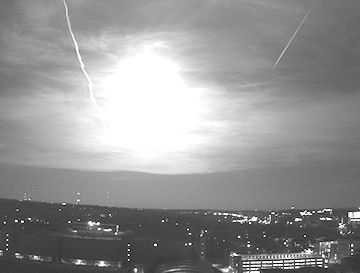NEW AND IMPROVED: Turn your iPhone or iPod Touch into a field-tested global satellite tracker. The Satellite Flybys app now works in all countries. | | | VOLCANIC SUNSET ALERT: For the second day in a row, clouds of ash from Iceland's Eyjafjallajokull volcano are drifting across Europe. This has forced the closure of some of Europe's busiest airports, grounding thousands of planes. Stranded passengers should look west at the end of the day for their consolation prize: the ash is causing sunsets of rare beauty. Images: #1, #2, #3, #4, #5, #6, #7, #8, #9, #10. BONUS: If you don't live in Europe, look west anyway. Venus, Mercury and the crescent Moon are beaming through the twilight for all to see. Sky maps: April 15, 16. MIDWESTERN FIREBALL: Last night, around 10:05 pm CDT, sky watchers in Minnesota, Wisconsin, Iowa, Illinois and Missouri witnessed a brilliant green fireball streaking across the sky. Images from a rooftop webcam in Madison, Wisconsin, show a brilliant midair explosion: 
Credit: University of Wisconsin - AOS/SSEC
The fireball was caused by a small asteroid hitting Earth's atmosphere at a shallow angle. Preliminary infrasound measurements place the energy of the blast at 20 tons of TNT (0.02 kton), with considerable uncertainty. Bill Cooke of NASA's Meteoroid Environment Office estimates that the space rock was about 1 meter wide and massed some 1260 kg. "Fireballs of this size are surprisingly common," he notes. "They hit Earth about 14 times a month, on average, although most go unnoticed because they appear during the day or over unpopulated areas." Many readers have asked if fragments of the meteoroid might have reached Earth. The answer is "yes." Cooke advises looking directly underneath the fireball's debris trail, which was pinged by National Weather Service radars in Iowa. Click here and here for maps. News video: from WISN in Milwaukee, Wisconsin; from a sheriff's dashcam in Elma, Iowa; Not a gamma Virginid: Contrary to some reports, this fireball was not a member of the gamma Virginid meteor shower, a minor shower that peaks in mid-April. The fireball's timing and trajectory do not match what would be expected for a gamma Virginid. AURORA WATCH: High-latitude sky watchers should be alert for auroras on April 17th when a coronal mass ejection (CME) is expected to deliver a glancing blow to Earth's magnetic field. NOAA forecasters estimate a 35% chance of geomagnetic activity: 
"On April 14th I took a little trip to see the Northern Lights with my students from Salluit, an Inuit village in the Canadian Arctic," says photographer Sylvain Serre. "It was spectacular. I especially enjoyed hearing my students whistle to make the auroras dance." UPDATED: April Northern Lights Gallery
[previous Aprils: 2009, 2008, 2007, 2006, 2005, 2004, 2003, 2002]
| 
